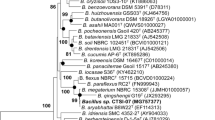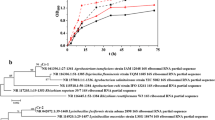Abstract
Microbial Cr(VI) reduction is a significant process in detoxification of Cr(VI) pollution. In this study, a new Cr(VI)-reducing bacterial strain, Cr-4, was isolated from soil around the chromium-containing slag. The analysis of the 16S ribosomal RNA (rRNA) gene sequence revealed that the newly isolated strain was closely related to Bacillus anthracis. The response to Cr(VI) stress and reduction capacity of the isolate were investigated. Cell growth decreased with the increase of Cr(VI) concentration. Cell morphology varied and cell growth was inhibited remarkably in the presence of 125 mg/L Cr(VI). The strain grew well and removed Cr(VI) effectively at a Cr(VI) concentration lower than 50 mg/L. Cr(VI)-reducing activity was inhibited by Zn2+, while significantly stimulated by Cu2+. The activity of Cr(VI) reduction by cell-free extract was demonstrated. Total chromium analysis and the energy-dispersive X-ray analysis (EDAX) spectrum revealed that Cr(VI) removal was caused mainly by microbial reduction rather than by biosorption and the main part of the reduced Cr(III) existed as soluble form in solutions.







Similar content being viewed by others
References
Abe, F., Miura, T., Nagahama, T., Inoue, A., Usami, R., & Horikoshi, K. (2001). Isolation of a highly copper-tolerant yeast, Cryptococcus sp. from the Japan Trench and the induction of superoxide dismutase activity by Cu2+. Biotechnology Letters, 23(24), 2027–2034.
Accornero, M., Marini, L., & Lelli, M. (2010). Prediction of the thermodynamic properties of metal–chromate aqueous complexes to high temperatures and pressures and implications for the speciation of hexavalent chromium in some natural waters. Applied Geochemistry, 25(2), 242–260.
Ackerley, D. F., Gonzalez, C. F., Park, C. H., Blake, R., Keyhan, A., & Matin, A. (2004). Chromate-reducing properties of soluble flavoproteins from Pseudomonas putida and Escherichia coli. Applied and Environmental Microbiology, 70(2), 873–882.
Camargo, F. A. O., Okeke, B. C., Bento, F. M., & Frankenberger, W. T. (2003). In vitro reduction of hexavalent chromium by a cell-free extract of Bacillus sp. ES 29 stimulated by Cu2+. Applied Microbiology and Biotechnology, 62(5–6), 569–573.
Chardin, B., Giudici-Orticoni, M. T., De Luca, G., Guigliarelli, B., & Bruschi, M. (2003). Hydrogenases in sulfate-reducing bacteria function as chromium reductase. Applied Microbiology and Biotechnology, 63(3), 315–321.
Chen, H., Li, X. J., & Xu, Z. W. (2011). Cr(VI) remediation by enriched sediment with anthraquinone-2,6-disulfonate as electron shuttles. Physics and Chemistry of the Earth, 36(9–11), 451–454.
Chen, Z., Huang, Z. P., Cheng, Y. J., Pan, D. M., Pan, X. H., Yu, M. J., et al. (2012). Cr(VI) uptake mechanism of Bacillus cereus. Chemosphere, 87(3), 211–216.
Cheung, K. H., & Gu, J. D. (2003). Reduction of chromate (CrO42-) by an enrichment consortium and an isolate of marine sulfate-reducing bacteria. Chemosphere, 52(9), 1523–1529.
Cirik, K., Dursun, N., Sahinkaya, E., & Cinar, O. (2013). Effect of electron donor source on the treatment of Cr(VI)-containing textile wastewater using sulfate-reducing fluidized bed reactors (FBRs). Bioresource Technology, 133, 414–420.
Contreras, E. M., Orozco, A. M. F., & Zaritzky, N. E. (2011). Biological Cr(VI) removal coupled with biomass growth, biomass decay, and multiple substrate limitation. Water Research, 45(10), 3034–3046.
Cummings, D. E., Fendorf, S., Singh, N., Sani, R. K., Peyton, B. M., & Magnuson, T. S. (2007). Reduction of Cr(VI) under acidic conditions by the facultative Fe(III)-reducing bacterium Acidiphilium cryptum. Environmental Science & Technology, 41(1), 146–152.
Desai, C., Jain, K., & Madamwar, D. (2008). Hexavalent chromate reductase activity in cytosolic fractions of Pseudomonas sp. G1DM21 isolated from Cr(VI) contaminated industrial landfill. Process Biochemistry, 43(7), 713–721.
Focardi, S., Pepi, M., Landi, G., Gasperini, S., Ruta, M., Di Biasio, P., et al. (2012). Hexavalent chromium reduction by whole cells and cell free extract of the moderate halophilic bacterial strain Halomonas sp. TA-04. International Biodeterioration & Biodegradation, 66(1), 63–70.
He, M. Y., Li, X. Y., Liu, H. L., Miller, S. J., Wang, G. J., & Rensing, C. (2011). Characterization and genomic analysis of a highly chromate resistant and reducing bacterial strain Lysinibacillus fusiformis ZC1. Journal of Hazardous Materials, 185(2–3), 682–688.
Kantar, C., Demiray, H., & Dogan, N. M. (2011). Role of microbial exopolymeric substances (EPS) on chromium sorption and transport in heterogeneous subsurface soils: II. Binding of Cr(III) in EPS/soil system. Chemosphere, 82(10), 1496–1505.
Lin, Z., Zhu, Y., Kalabegishvili, T. L., Tsibakhashvili, N. Y., & Holman, H. Y. (2006). Effect of chromate action on morphology of basalt-inhabiting bacteria. Materials Science & Engineering C-Biomimetic and Supramolecular Systems, 26(4), 610–612.
Lovley, D. R., & Phillips, E. J. P. (1994). Reduction of chromate by Desulfovibrio vulgaris and its c3 cytochrome. Applied and Environmental Microbiology, 60(2), 726–728.
Mangaiyarkarasi, M. S. M., Vincent, S., Janarthanan, S., Rao, T. S., & Tata, B. V. R. (2011). Bioreduction of Cr(VI) by alkaliphilic Bacillus subtilis and interaction of the membrane groups. Saudi Journal of Biological Sciences, 18(2), 157–167.
Martins, M., Faleiro, M. L., Chaves, S., Tenreiro, R., Santos, E., & Costa, M. C. (2010). Anaerobic bio-removal of uranium (VI) and chromium (VI): comparison of microbial community structure. Journal of Hazardous Materials, 176(1–3), 1065–1072.
Michel, C., Brugna, M., Aubert, C., Bernadac, A., & Bruschi, M. (2001). Enzymatic reduction of chromate: comparative studies using sulfate reducing bacteria—key role of polyheme cytochromes c and hydrogenases. Applied Microbiology and Biotechnology, 55(1), 95–100.
Mistry, K., Desai, C., & Krishna, P. (2010). Chromate reduction by Vogococcus sp. isolated from Cr(VI) contaminated industrial effluent. Electronic Journal of Biology, 6(1), 6–12.
Pagnanelli, F., Cruz Viggi, C., Cibati, A., Uccelletti, D., Toro, L., & Palleschi, C. (2012). Biotreatment of Cr(VI) contaminated waters by sulphate reducing bacteria fed with ethanol. Journal of Hazardous Materials, 199, 186–192.
Pal, A., Dutta, S., & Paul, A. K. (2005). Reduction of hexavalent chromium by cell-free extract of Bacillus sphaericus AND 303 isolated from serpentine soil. Current Microbiology, 51(5), 327–330.
Romanenko, V. I., & Koreńkov, V. N. (1977). A pure culture of bacteria utilizing chromate and dichromate as hydrogen acceptors in growth under anaerobic conditions. Mikrobiologiya, 46(3), 414–417.
Sahinkaya, E., Altun, M., Bektas, S., & Komnitsas, K. (2012). Bioreduction of Cr(VI) from acidic wastewaters in a sulfidogenic ABR. Minerals Engineering, 32, 38–44.
Sau, G. B., Chatterjee, S., & Mukherjee, S. K. (2010). Chromate reduction by cell-free extract of Bacillus firmus KUCrl. Polish Journal of Microbiology, 59(3), 185–190.
Sugiyama, T., Sugito, H., Mamiya, K., Suzuki, Y., Ando, K., & Ohnuki, T. (2012). Hexavalent chromium reduction by an actinobacterium Flexivirga alba ST13T in the family Dermacoccaceae. Journal of Bioscience and Bioengineering, 113(3), 367–371.
Sultan, S., & Hasnain, S. (2007). Reduction of toxic hexavalent chromium by Ochrobactrum intermedium strain SDCr-5 stimulated by heavy metals. Bioresource Technology, 98(2), 340–344.
Sultan, S., & Hasnain, S. (2012). Chromium (VI) reduction by cell free extract of Ochrobactrum anthropi isolated from tannery effluent. Bulletin of Environmental Contamination and Toxicology, 89(1), 152–157.
Thacker, U., Parikh, R., Shouche, Y., & Madamwar, D. (2007). Reduction of chromate by cell-free extract of Brucella sp. isolated from Cr(VI) contaminated sites. Bioresource Technology, 98(8), 1541–1547.
Wang, P. C., Mori, T., Toda, K., & Ohtake, H. (1990). Membrane-associated chromate reductase activity from Enterobacter cloacae. The Journal of Bacteriology, 172(3), 1670–1672.
Xu, W. H., Liu, Y. G., Zeng, G. M., Li, X., Tang, C. F., & Yuan, X. Z. (2005). Enhancing effect of iron on chromate reduction by Cellulomonas flavigena. Journal of Hazardous Materials, 126(1–3), 17–22.
Xu, W. H., Liu, Y. G., Zeng, G. M., Li, X., Song, H. X., & Peng, Q. Q. (2009). Characterization of Cr(VI) resistance and reduction by Pseudomonas aeruginosa. Transactions of Nonferrous Metals Society of China, 19(5), 1336–1341.
Acknowledgments
This work was supported by the National Natural Science Foundation of China (51108167) and the Fundamental Research Funds for the Central Universities, Hunan University.
Author information
Authors and Affiliations
Corresponding author
Rights and permissions
About this article
Cite this article
Xu, WH., Jian, H., Liu, YG. et al. Bioreduction of Chromate by an Isolated Bacillus anthracis Cr-4 with Soluble Cr(III) Product. Water Air Soil Pollut 226, 82 (2015). https://doi.org/10.1007/s11270-015-2356-z
Received:
Accepted:
Published:
DOI: https://doi.org/10.1007/s11270-015-2356-z




